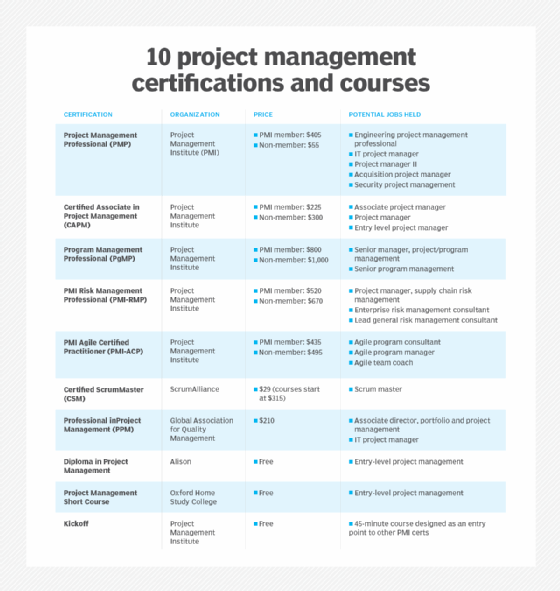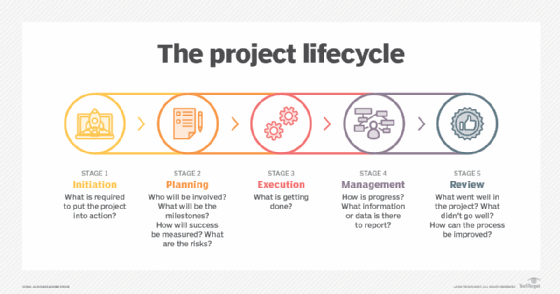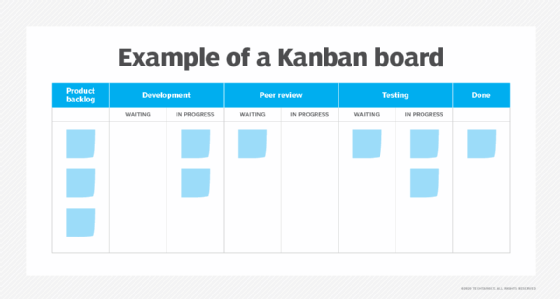IT project management
What is IT project management?
IT project management is the process of planning, organizing and delineating responsibility for the completion of an organizations' specific information technology goals.
IT project management includes overseeing projects for software development, hardware installations, network upgrades, cloud computing and virtualization rollouts, business analytics and data management projects and implementing IT services.
Besides the normal problems that can cause a project to fail, factors that can negatively affect success of an IT project. These include advances in technology during the project's execution; infrastructure changes that impact security and data management; and unknown dependent relationships among hardware, software, network infrastructure and data.
IT projects might also succumb to the first-time, first-use penalty, which is the total risk an organization assumes when implementing a new technology for the first time. Complications are likely to affect the chances of success for a first-time project.
What does an IT project manager do?
A typical IT project manager (PM) spends their day in meetings, reviewing project activities against the plan, orchestrating activities to correct project issues, monitoring progress against the budget, providing status reports to stakeholders, and briefing business unit leaders and senior management, among many others.
Regular meetings with IT department heads on the project team are especially important, as their contributions influence greatly whether the project is completed as planned. Discussions with vendors supporting the project are also important, especially when checking on deliveries of components and checking expenses again the budget,
The PM must also act as a cheerleader for the project, motivating project team members and IT employees supporting the project.
If the PM is using a software package to monitor the project, regular daily visits to the system are needed to ensure things are on track. The PM will likely spend time on the system after hours to identify issues that might need attention before they create a problem in the project schedule.
What skills do IT project managers need?
In addition to first-hand knowledge of IT systems and operations, IT project managers should have significant PM and problem-solving skills and expertise, often gained early in their careers. A bachelor's degree in areas such as computer science, business management or information systems is often required. Building on their education and experience, PMs can take relevant online self-study classes and pursue professional PM certifications and degree programs.
PM professionals and candidates have many options to establish and further their education. Many established universities offer project management certifications Specialized firms such as the Project Management Institute offer the Certified Associate in Project Management and Project Management Professional certification.

Managing the project
While specific phases in a project are unique to each project, these five process groups are universal and comprise the project management lifecycle:
- Initiation. The project goal, need or problem is identified. The project is assigned and project charter is created.
- Planning. The PM and the project team collaborate to plan all the steps needed for success. The project planning processes are iterative, and it's expected that planning will happen often throughout the project.
- Execution. Once the project plan is created, the project team goes implements the plan to create the project deliverables. The project can shift to project planning as needed throughout project execution.
- Monitoring and controlling. As the project is being executed, the PM monitors and controls the work for time, cost, scope, quality, risk and other factors. Ongoing monitoring and controlling ensure the project addresses its targets for each objective.
- Closing. At the end of each phase and the entire project, project closure happens to ensure all the work was completed on time, all the work is approved, and ownership is transferred from the project team to operations.

Managing the project knowledge areas
There are ten knowledge areas where a PM is expected to deliver value throughout the project:
- Project scope management. The scope is defined, documented and approved. It's protected from unauthorized changes, edited with approved changes and validated by stakeholders for project acceptance.
- Project schedule management. The schedule is defined first by the working hours of the project, any milestones and a deadline. The project team's availability throughout the project is documented and planned accordingly. The PM works with the project team to identify the tasks and task duration estimates to create a timeline.
- Project costs management. Project costs are estimated so a budget can be set. These costs include materials, pricing, services, facilities, software licenses and other expenses attributed directly to the project.
- Project quality management. What constitutes quality is defined in specific metrics and agreed upon among the stakeholders as early in the project as possible. Quality assurance programs and policies direct the work, while quality control inspects the work to confirm that the quality measures are met.
- Project human resources management. The PM works with the project team to verify that IT team members are completing their assignments and leveraging their knowledge while working well with others. The PM informs managers of these contributors about their participation and performance.
- Project communications management. Stakeholders will rely on the PM for information throughout the project lifecycle. PMs skilled in this knowledge area typically create a communications management plan to address who will need what information, when the information is needed and what modality is best for the communications.
- Project risk management. Risks are situations, events and conditions that can threaten or sometimes benefit IT project objectives. Risk management involves identifying and analyzing risks as well as creating a response for each risk event. The probability and impact of each risk event is evaluated to create a risk score to justify the costs needed to manage the risk event.
- Project procurement management. Should the project need to purchase goods or services, a formal process for procurement is necessary. The plan should address contract type and administration, purchasing audits, and contract closeout. Many PMs do not manage procurement, instead deferring to the organization's centralized procurement or purchasing department and processes.
- Project stakeholder management. Stakeholders include anyone with a vested interest in the project. Stakeholder management is the identification of, inclusion of and communication with the groups of stakeholders. The goal is to manage concerns the stakeholders might have.
- Project integration management. This involves the coordination of the events in all the other knowledge areas. How well the PM performs in one knowledge area directly affects the performance of the other areas. Project integration management examines the interactions and contingencies among the knowledge areas to ensure the project is adequately planned, executed, controlled and closed.
- Project completion and reporting to IT management. As the project reaches completion, the PM should be prepared to close out the project as completed, providing evidence verifying that the new system is in production and performing as expected as well as closing out any connections between internal and external participants. The PM should also prepare a report to senior management and IT management on the project's completion, citing issues that were addressed and lessons learned, explaining how the new system will benefit the organization, and recommending follow-up steps.
Except for procurement, all these knowledge areas will be relevant in every project. They can occur iteratively, and there is no set order for managing them. PMs shift to the appropriate knowledge and processes based on what's occurring in the project.
What is IT project lifecycle?
The project lifecycle of a typical IT project moves through iterations of several activities. These include planning, executing and controlling until the project is ultimately closed and transferred into operations. Organizations can select one of several popular approaches to reduce the risk of expensive rework, risks from quickly changing technology, or expansive planning at project launch.
The approaches align to three distinct IT project management lifecycles.
What is predictive lifecycle?
This is the most common, traditional project lifecycle for IT projects. In this approach, the PM and project team first define the project scope, project schedule and expected costs before project execution begins. As part of the project planning, each phase of the project should be clearly defined. Each phase involves a specific type of project work. For the project to move from its initiation to closure, each phase must be started and completed in the specific order as planned. This is named the Waterfall approach as the project "waterfalls" down the project phases.
What is iterative lifecycle?
This approach requires that the project management be defined early, but cost and activity duration estimates are planned at a higher level. As project execution occurs, cost and duration estimates are created for the most imminent work through iterative planning. This approach also calls for iterations of benefits to be released to the organization. An iterative lifecycle may create a new software with more features provided in each new release.
What is adaptive lifecycle?
This project lifecycle also uses an iteration of planning and executing, but the planning may last for two to four weeks. This approach uses a rolling wave of planning and executing through short bursts of both planning and executing. Change is expected in this approach to the IT project and it is ideal for software development projects. Agile project management and Scrum are examples of the adaptive lifecycle.
A variant of the Agile approach is the Kanban framework, which has a philosophy of continuous improvement and uses "Kanban boards" to visually show where project activities are in the course of the overall project.

Each of these lifecycles uses the concept of phases to move the project work forward. A phase describes the type of work that will occur in that portion of the project. The PM, the organizational requirements and even customer requirements can influence selection of the types of project lifecycle the PM will adapt in the project.
IT project management software
Building an IT project plan can occur with tools as rudimentary as an Excel spreadsheet or as advanced as Microsoft Project. The former is useful for simple projects; the latter can be scaled to support large, complex projects.
More sophisticated systems are available to handle just about any kind of project. Organizations should take advantage of a free demo if the vendor offers it before making a purchase. One project management software system to consider is Wrike, a cloud-based system that supports all sizes of projects. Other flexible, scalable online project management tools include Project Insight, BigTime and Monday.com.
Check out open source products also. Most vendors offer free and paid versions. The integration of artificial intelligence (AI) elements into PM software is an important advancement. PMs will appreciate AI for its ability to anticipate potential problems before they occur.
Creating a project management plan
Once the intended result, or end game, is identified, it's often a good idea to identify various completion points or decision points. This will flag the steps needed to complete the project. The methodology to use, such as Waterfall or Agile, can then be selected.
Once the key action points are known, sub-processes needed for timely completion of the activities can be defined. While these activities are being developed, they can be incorporated in whatever project management methodology is being used.
As the various activities are being defined, periodic team meetings are advisable to ensure that all team members are aligned with the project's direction. In parallel to project activities, milestones can be established, budgets defined and approved, team members advised on their assignments and responsibilities, and regular briefings set with senior management to ensure their ongoing support.
Flexibility in the structure of the methodology is important because changes to aspects of the project are inevitable. The project plan and, if used, project management software must automatically adjust time frames, budgets, staffing and other variables as changes occur.
Managing risk in IT projects
As with any project, risk must be accounted for. Risks can occur at any point, so the key is to accept that risks will be present, anticipate and identify them, review their likelihood and importance, and define ways to mitigate their impact.
If project management software is to be used, see if it can identify and analyze potential risks, threats and vulnerabilities that may affect the project's success. It's also advisable to perform a risk assessment before the project starts. This is where AI might be helpful; it could streamline the process and also later reassess risks.
Project, program and portfolio management are related but represent distinct disciplines. Learn about the responsibilities and goals of each as well as how they differ.






